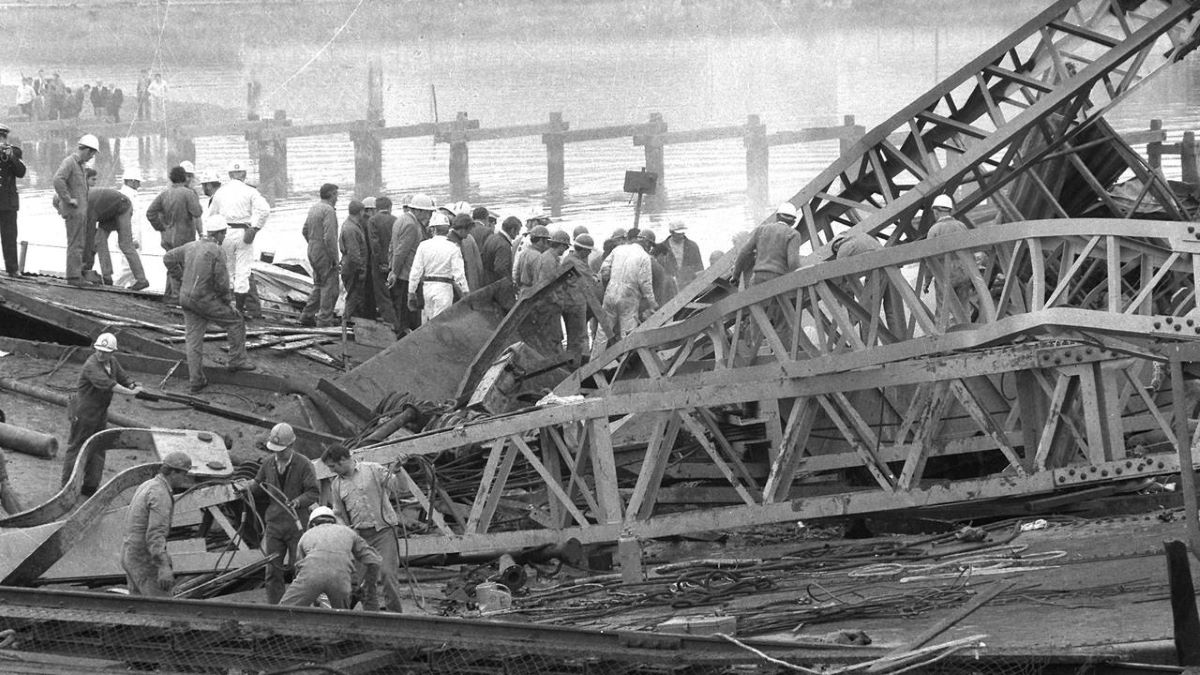On 15 October 1970, a portion of the West Gate Bridge in Melbourne collapsed, killing 35 people.
The West Gate Bridge is a steel box girder cable-stayed bridge in Melbourne, Victoria, Australia, spanning the Yarra River just north of its mouth into Port Phillip.
It is a vital link between the inner city (CBD) and Melbourne’s western suburbs, with the industrial suburbs in the west, and with the city of Geelong 80 kilometres (50 mi) to the south-west. It is part of one of the busiest road corridors in Australia.
The main river span is 336 metres (1,102 ft) in length, and the height above the water is 58 metres (190 ft). The total length of the bridge is 2,582.6 metres (8,473 ft). It is the fifth-longest in Australia, the longest being Melbourne’s Bolte Bridge at 5 kilometres (3.1 mi).
The West Gate Bridge is twice as long as the Sydney Harbour Bridge and is one of the highest road decks in Australia, clearing the water at 58 metres (190 ft), with the Sydney Harbour Bridge clearing the water at 49 metres (161 ft).
The bridge passes over Westgate Park, a large environmental and recreational reserve created during the bridge’s construction, and carries up to 200,000 vehicles per day.
Collapse
Two years into construction of the bridge, at 11:50 am on 15 October 1970, the 112-metre (367-foot) span between piers 10 and 11 collapsed and fell 50 metres (164 feet) to the ground and water below.
Thirty-five construction workers were killed and 18 injured, and it remains Australia’s worst industrial accident. Many of those who died were on lunch break beneath the structure in workers’ huts, which were crushed by the falling span. Others were working on and inside the span when it fell.
The whole 2,000-tonne (4,400,000 lb) mass plummeted into the Yarra River mud with an explosion of gas, dust and mangled metal that shook buildings hundreds of metres away. Nearby houses were spattered with flying mud.
The roar of the impact, the explosion, and the fire that followed, could be clearly heard over 20 kilometres (12 mi) away.
On the following morning, 16 October, Sir Henry Bolte (Premier of Victoria) announced that a Royal Commission would be set up immediately to look into the cause of the disaster.
The Prime Minister, John Gorton, said: “I am sure the whole of Australia is shocked and saddened by the serious accident at West Gate Bridge. Please extend my deepest sympathy to all those families to whom this tragic event has brought such grief.”
Cause
A Royal Commission into the collapse was established, which concluded on 14 July 1971. It attributed the failure of the bridge to two causes: the structural design by designers Freeman Fox & Partners, and an unusual method of construction by World Services and Construction, the original contractors for the project.
On the day of the collapse, there was a difference in camber of 11.4 centimetres (4.5 in) between two half-girders at the west end of the span which needed to be joined. It was proposed that the higher one be weighted down with 10 concrete blocks, each weighing 8 t (8.8 short tons), which were located on-site.
The weight of those blocks caused the span to buckle, which was a sign of structural failure. The longitudinal joining of the half-girders was partially complete when orders came through to remove the buckle. As the bolts were removed, the bridge snapped back and the span collapsed.
Collapse memorials
Six twisted fragments of the collapsed bridge can be found in the West Gate garden at the engineering faculty of Monash University, Clayton campus. The university acquired them after being asked to participate in the investigation of the collapse. It is said that they are to remind engineers of the consequences of their errors.
Commemorations have been held on 15 October every year since the collapse.
A West Gate Bridge Memorial Park to workers who lost their lives is located near the bridge. It opened on 15 October 2004, the 34th anniversary of the collapse. It includes the existing West Gate Bridge Memorial and Sculpture, and the memorial for six who died in the Spotswood Yarra Sewer Tunnel collapse of 12 April 1895 (Good Friday).
To see other events that happened in Australian history, visit the blog site of Advance Institute of Business by clicking on this link.
Advance Institute of Business has nationally recogised Certificate and Diploma courses available to help you progress in your career.
The Certificate IV in TESOL will allow you to teach English in Australia and many other countries.
The 10773NAT Certificate IV in TESOL is a nationally and internationally recognised qualification that will allow you to teach English to speakers of other languages in Australia and many other countries.
The practical component can be done in your own country (conditions apply), Vietnam or Cambodia. If you choose to do the practical component in Vietnam or Cambodia, we will provide hotel accommodation at no extra cost.
We have the following Certificate and Diploma courses available for your career development:
Teaching Courses
Business
Leadership and Management
Entrepreneurship and New Business
- Certificate III in Entrepreneurship and New Business
- Certificate IV in Entrepreneurship and New Business
Accounting
We will soon also be offering:
- Advanced Diploma of Business
- Diploma of Human Resource Management
- Diploma of Marketing and Communication
And there will be more courses to come in the future.
Our non-accredited speciality courses:
- Career Paths (43 career paths to choose from)
- Corporate Training
- Business English
- English Tutoring
- University and College Tutoring
- Professional and Academic Writing Skills
- Where to Study in Australia
- Education Consultancy
25% discount on all courses for Centrelink and Veteran’s Affairs recipients.
All courses are nationally recognised through our Registered Training Organisation partner Skills Recognition International (RTO 32373). We also have an advisory service on where to study in Australia.
To find out more about these courses, please click this link to arrange a free video or phone call.
Discover more from Craig Hill Media
Subscribe to get the latest posts to your email.




2 thoughts on “On this day (Australia): In 1970, a portion of the West Gate Bridge in Melbourne collapsed, killing 35 people”